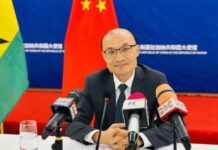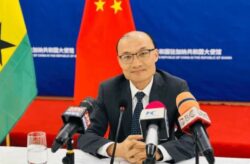By Haruna Seidu
It was refreshing and heartwarming to have witnessed a significant milestone achieved towards continental integration when the Africa Continental Free Trade Area (AfCFTA) agreement was signed and ratified by many member states. Subsequently, with the introduction of the Pan Africa Payment & Settlement System (PAPSS) by Afreximbank, which is the clearing and settlement platform for trade finance activities executed among African countries.
Critical enablers and lifeline for International Trade are medium and currency of settlement, therefore, the introduction of PAPSS by Afrexim is seemingly expected to cure that mounting hurdle for Intra Africa Trade, never in the history of the continent has it come far to something this significant.
Close to half of trade activities in Africa are settled in United States Dollars (USD), as a result, the continent loses close to $5bn in associated cost for settlement in USD with banks in the United States of America (USA). Sometimes some of these cross-border payments are between neighboring African countries or Economic Zones.
No doubt there is momentum behind this bold initiative by the leaders of Africa, however the implementation is anchored on smart choices and very critical policy options. The question or the highly debatable issue is, will Africa be able to rise to this challenge especially now, with intense competing interests between the Global South and North over the continent. Yes, AfCFTA is the second largest free trade area after the establishment of World Trade Organisation (WTO) in 1994. This free trade area is expected to enhance the competitiveness of African industries, resources optimization, access to a broader market and competitiveness of economies of scale.
If AfCFTA’s goals are fully realized, 50 million people could escape extreme poverty by 2035, and real income could rise by 9 percent. Under deep integration, Africa’s exports to the rest of the world would go up by 32 percent by 2035, and intra-African exports would grow by 109 percent, led by manufactured goods (World Bank Publication, June 30, 2022).
To achieve these bold and strategic goals, there is the need for Africa to cast broader and further the sphere of its engagements to include similar initiatives implemented in some parts of the globe.
Critical Policy Options
According to Landry Signé, Managing Director and Professor at the Thunderbird School of Global Management, during a testimony before the Senate Committee on US-Africa Relations, reiterated that under a successfully implemented AfCFTA, Africa will have a combined consumer and business spending of $6.7 trillion by 2030 and $16.12 trillion by 2050, creating a unique opportunity for people and businesses, meaning the region can be the next big market for American goods and services.
A well-disciplined approach to policy options will be critically required for member countries and key stakeholders in driving this continental agenda to a resounding success. For instance, AfCFTA’s governance structures must be professionally protected, and its framework compartmentalized to promote inclusion and participation. Effectively, AfCFTA must be lean and efficient by undertaking strategic tasks rather than doing everything itself. Learning from past continental initiatives is essential to harness the energy and creativity of African women and youth, which will strengthen AfCFTA agenda in establishing one of the world’s largest free trade areas.
Transforming the continent’s youth and women into Africa’s demographic dividend will involve substantial investments in education, access to financial support, bridging the digital divide and increased opportunities. The synergy of youth and women is explosive and transformative for development.
Rethinking the continental financial architecture to integrate youth and women as drivers of cross-border trade while stimulating and strengthening access and inclusion should be a priority for the future.
Strategic Relationships:
EU-Africa
The European Union (EU) admits the need for strong EU support to the establishment and implementation of the African Continental Free Trade Area (AfCFTA). There are important challenges and opportunities to be considered in the further operationalisation of intra-African trade relations. Africa and EU, for instance should consider strengthening cooperation in private sector development, trade facilitation support, domestic resource mobilization, adjustment policies etc. and potentially deeper provisions in existing cross-continent integration schemes, such as EU investment commitments.
Expectations
Building the African continental value chains through AfCFTA will rely on economies of scale to make specialization and accompanying investments economically viable. The EU market of roughly 450 million consumers can provide purchasing power in addition to the one of Africa’s growing middle class, investments, and private sector cooperation.
The European Partnership Agreements (EPAs), which are trade and development agreements negotiated between the EU and African, Caribbean, and Pacific (ACP) countries open up EU markets fully and immediately, whereas ACP partners open only partially to EU imports, over transitioning periods. These initiatives through the EPAs have successfully linked the African and European markets for members. Between 2009 and 2021, African EPA countries’ exports to the EU has increased by 91%, whereas exports of trade with non-EPA countries in Sub Sahara Africa increased only by half of it.
EU-Africa trade agreements can also contribute to the diversification of trade, as African EPA partner countries have achieved growth in value of exports of processed products by 126% between 2009 and 2021. Export capacities of African EPA countries will help to drive the trade of processed and manufactured goods under the AfCFTA. Key objective of AfCFTA is to foster industrialisation, which often relies on foreign direct investment (FDI).
The EPAs support attracting FDI, for instance between 2013 and 2019, the total of EU FDI stocks in African EPA countries has increased by 18.3% while over the same period, the stocks of EU FDI in non-EPA countries in Sub Sahara Africa has decreased by 6.2% (European Commission Report -Synergies between AfCFTA and EU- Africa Trade Agreements)
The EU’s new sustainable investment initiative also aims to mobilize more investment by offering stand-alone sustainable investment agreements or modernise existing trade agreements in conjunction with EU development cooperation. Angola has started to negotiate the first ever Sustainable Investment Facilitation Agreement.
Challenges
EU-African and inner-African trade faces similar challenges, for example in the areas of non-tariff barriers, trade facilitation and or lack of investment in continental infrastructure. The EU’s Economic Partnership Agreements as well as future Sustainable Investment Agreements are supported by EU development cooperation. Training customs or trade officials or enhancing electronic customs systems in the context of EU-Africa trade agreements will have positive spill-over effects for facilitating inner-African trade.
AfCFTA agreement explicitly foresees a role for development partners to support by providing technical assistance and capacity building to help state parties to implement the AfCFTA, for example in the areas of trade in goods and services. The same logic applies to private sector traders.
The EU should consider support to the AfCFTA and to the EU’s current trade agreements with African countries as complementary and mutually reinforcing. The Joint Declaration of the last EU-Africa Summit in Brussels on 17- 18 February 2022 highlighted the common objective “to promote trade and investment in Africa, thereby contributing to sustainable development, growth and job creation.”
China– Africa
China has been involved with the AfCFTA through capacity-building support for the secretariat, and major infrastructure investments across Africa within the framework of the Forum on China-Africa Cooperation (FOCAC), Dakar Action Plan (2022-2024). In 2021, the AfCFTA secretariat and China’s Ministry of Commerce signed a memorandum of understanding to establish an expert group to collaborate and share experiences on intellectual property rights, customs procedures, digital trade, and competition policy, and to exchange concepts and progress on institutional capacity and implementation of AfCFTA
The China-Africa Cooperation Vision 2035 has outlined the medium- and long-term areas and objectives of cooperation. Within this framework, initiatives including the Action Plan for Boosting Intra-African Trade (BIAT), and closer Belt and Road partnership between China and Africa, among others, will be pursued. China’s growing market shares and technological innovations have had implications for international technical standardization, leading to the risk of split of standards and value chains.
China’s annual FDI flows into Africa have seen significant growth over the years. The China Africa Research Initiative estimated Chinese FDI at $4.2 billion in 2020, up from $75 million in 2003. A report by the Swiss African Business Circle estimated that China directed on average 27% of its investments in Africa over the past decade. Investments in Africa are into projects, jobs creation, and capital. From 2014 to 2018, China accounted for the largest share of jobs created and capital inflows to Africa.
In this same period, the United States and France were the largest investors when it came to projects, followed by the United Kingdom and China. As of 2021, UNCTAD figures indicate that European investors remain the largest holders of foreign assets in Africa, led by the United Kingdom ($65 billion) and France ($60 billion). Pre-Brexit EU investment stocks amounted to €261 billion, representing 40% of FDI in Africa. With the United Kingdom’s exit, the EU share has drastically declined. France is now the EU’s largest investor in Africa, albeit with no stock increases since 2013. China became Africa’s biggest bilateral trading partner in 2021, with Chinese African trade reaching $254 billion.
Exports to Africa are up 35.3% year-on-year while imports are up 43.7% year-on-year (General Administration of Customs of China). Total bilateral trade between China and Africa in 2021 was to be $254.3 billion, of which Africa exported $105.9 billion of goods to China, according General Administration of Customs of China.
Conclusion
A Shared Strategic Vision
The existing trade agreements between Africa and the various Economic Blocs across the globe have contributed to the strengthening and deepening of trade and economic development between the respective continents. It is crucial that Africa continues to work gradually towards the progressive and mutually beneficial integration of these respective continental markets.
For AfCFTA to succeed, these strategic partnerships would be required to provide support in key areas, for instance facilitation of AfCFTA negotiation, improving systems for Intellectual Property Rights, developing AfCFTA national implementation strategies, creation of the AU Trade Observatory and enhancing the effective application of Rules of Origin by customs administrations.
Almost all multilateral institutions, Economic Blocks across the globe agree on one thing, which is transformational impact of AfCFTA for the African continent. Africa has come far and there will be no other choice at this point but to make this work because failure is not an option for a continent with enormous potential of becoming a Global Trade Hub.
The writer is theGeneral Manager, Transaction Banking ,Consolidated Bank Ghana Limited .0206399433










